|
|
|
|
|
|
1655-2005:
350 Years of the Great
Meridian Line
by G.D. Cassini in the
Basilica of San Petronio in Bologna
(Italian version,
French version)
 To
express the authority of the city government, which opposed the ecclesiastical
authority represented by the pontifical legates, in 1388 the Commune of
Bologna passed a resolution to build a large new church dedicated to the
city’s patron saint, St. Petronius.
To
express the authority of the city government, which opposed the ecclesiastical
authority represented by the pontifical legates, in 1388 the Commune of
Bologna passed a resolution to build a large new church dedicated to the
city’s patron saint, St. Petronius.
The size of this edifice and its position, with its façade overlooking the
city’s main square, demonstrated the specific desire to merge religious faith
with civic ideals, eloquently expressing popular sentiment.
Designed by Antonio di Vincenzo, the basilica, built in the late Italian Gothic
style, was started in 1390 and completed in 1659, although the
façade was left unfinished.
The basilica was the site of numerous historic events, the most important of
which was the coronation of Charles V as the head of the Holy Roman Empire in
1530.
For many years, San Petronio was also the church of the University. From
the sixteenth to the nineteenth century, the university was located in the
adjacent Archiginnasio, and a church bell, known as “la scolara” [“the
pupil”], would chime to alert students that lectures were starting.
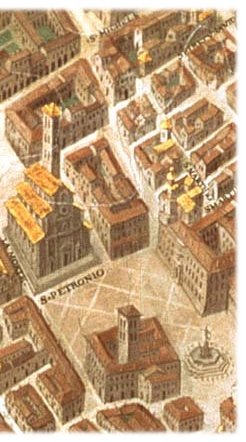 In
1575, the Dominican Egnazio Danti, cosmographer of Cosimo I de’ Medici,
was called to Bologna to teach Mathematics and Astronomy. Danti was part of the
Commission established by Pope Gregory XIII – a native of Bologna – to prepare a
new calendar. Known as the Gregorian calendar, it was promulgated
in 1582 and is the one we still use today.
In
1575, the Dominican Egnazio Danti, cosmographer of Cosimo I de’ Medici,
was called to Bologna to teach Mathematics and Astronomy. Danti was part of the
Commission established by Pope Gregory XIII – a native of Bologna – to prepare a
new calendar. Known as the Gregorian calendar, it was promulgated
in 1582 and is the one we still use today.
The study of the Sun’s movement over the course of the year, and determination
of the instants of the equinoxes and solstices marked some of the key
astronomical observations needed to arrive at the most accurate possible
definition of the duration of the tropical year for the purposes of establishing
the new calendar.
In the Church of Santa Maria Novella in Florence, Danti had already designed an
astronomical instrument to enhance the observation of solar motion: a
meridian line.
The spot of light produced on the floor of a large church by the Sun’s rays,
which came into the gloomy church interior through a small hole (the “eye” of
the meridian), made it possible to define the Sun’s position and the variations
in its motion far better than the shadows cast onto the ground by the enormous
gnomons used since antiquity.
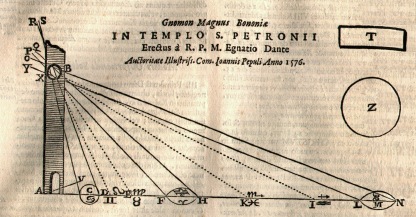 When
he arrived in Bologna, Egnazio Danti constructed a meridian inside San
Petronio (shown here in a drawing from Riccioli’s Almagestum Novum), which he
used to verify the epoch of the spring equinox.
When
he arrived in Bologna, Egnazio Danti constructed a meridian inside San
Petronio (shown here in a drawing from Riccioli’s Almagestum Novum), which he
used to verify the epoch of the spring equinox.
It is important to note that during this period – and despite the fact more than
thirty years had elapsed since Copernicus’ publication of De
Revolutionibus Orbium Coelestium, which illustrated the new heliocentric
system – it was still believed that the Earth was the centre of the universe.
Consequently, according to the accredited Aristotelian system, solar motion was
thought to be real and not apparent.
Less than a century after
Egnazio Danti’s meridian was completed, plans were made to demolish the back
wall of the left aisle in order to expand the basilica. Since the “eye” of
Danti’s meridian was positioned at the top of this wall, the sixteenth-century
instrument was destined to be destroyed.
In 1655, the Vestry Board of San Petronio decided entrust the project for a new
meridian line to «dottor Gian Domenico Cassini genovese» [«Dr.
Gian Domenico Cassini of Genoa»].
At the time, the young Cassini had been teaching astronomy in Bologna for
several years, and he was famed for the precision of his astronomical
observations. These observations included the comet of 1652, which he
demonstrated was far above the Moon’s orbit, contrary to Aristotelian concepts
whereby comets were vapours from the Earth’s atmosphere and not celestial
bodies.
Going against proposals to replace Danti’s
meridian line with a shorter one, which would have been decidedly less useful
for astronomical observations, Cassini submitted a daring new project.
Ingeniously exploiting the path between the columns of the Gothic nave, he
proposed increasing the height of Danti’s gnomon by one-third, thereby making
it 2.5 times longer in order to permit even more accurate observations.
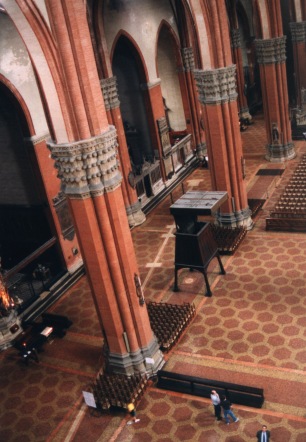 However,
to complete this work he had to overcome enormous financial, logistical,
technical and even “academic” difficulties.
However,
to complete this work he had to overcome enormous financial, logistical,
technical and even “academic” difficulties.
The nave and aisles of the large basilica, which had intentionally been built so
the church would face the city square, did not have a north-south orientation.
Thus, the chief technical difficulty lay in contriving a way to prevent the
Sun’s rays from being blocked by the columns while also exploiting the size of
the edifice as much as possible.
Based on careful observations of the Sun’s path
with respect to the walls of the church, the gnomonic hole was positioned in the
fourth vault of the left aisle, at a height of 1000 inches according to the
measurement system of the French foot (27.07 metres). On the ground level, the
length of the meridian line, as Cassini had predicted, was 1/600,000 of the
Earth’s circumference (66.71 metres).
For the summer solstice of 1655, Cassini published an announcement inviting all
citizens and university professors to attend the final verification of the
meridian line and the passage of the Sun’s image «fra quelle colonne, che
erasi creduto impedirne la descrizione» [«between those columns that were
thought would prevent its description»].
The work came to a total cost of 2500 lire (equivalent to about 200,000-250,000
euros today), of which 500 lire went to Cassini.
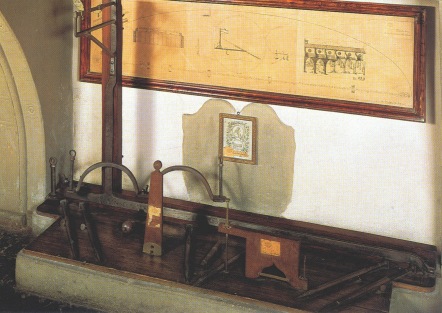 As
a result of the widespread fame Cassini gained not only with this instrument “to
measure the Sun” - which he himself named the “heliometer” - but also through
other important astronomical observations, Louis XIV called him to Paris
to help build the Observatoire Royal.
As
a result of the widespread fame Cassini gained not only with this instrument “to
measure the Sun” - which he himself named the “heliometer” - but also through
other important astronomical observations, Louis XIV called him to Paris
to help build the Observatoire Royal.
Cassini and his son Jacques returned to Bologna in 1695 to check the meridian
line, together with Domenico Guglielmini; the instruments they used for
this (shown in the side picture) are still preserved in the Basilica Museum.
Their determination at the spring equinox dispelled any doubts over whether or
not a leap year should be omitted in 1700, as envisaged by the Gregorian reform.
Eustachio Zanotti conducted further restoration work in 1776, whereas
later verification was done by Federico Guarducci in 1904.
 Cassini’s
avowed purpose for creating a 67-metre-long meridian line (the longest in
the world) was to determine the length of the tropical year as accurately
as possible by measuring the time elapsed between two subsequent passages of the
Sun at the spring equinox. This would make it possible to verify the correctness
of the Gregorian reform of the calendar.
Cassini’s
avowed purpose for creating a 67-metre-long meridian line (the longest in
the world) was to determine the length of the tropical year as accurately
as possible by measuring the time elapsed between two subsequent passages of the
Sun at the spring equinox. This would make it possible to verify the correctness
of the Gregorian reform of the calendar.
Nevertheless, Cassini’s true aim was quite different, as we can easily glean
from his use of this large instrument.
Less than twenty years after Galileo’s trial, he certainly could not declare
openly that he wanted to construct an instrument capable of settling the
controversy between those who subscribed to the view that the Sun followed a
circular and uniform path around the immobile Earth, and those who, instead,
sustained that the Earth moved around the Sun and that solar motion was merely
apparent.
The Sun seems to move across the heavens more
slowly in summer than in winter, and even in ancient times it was known that
the Sun was furthest from the Earth in summer. According to the ancients, it was
this greater distance that made its motion seem slower.
Nevertheless, many astronomers – including Kepler – posed another
question.
«Does the Sun seem to move more slowly simply because it is further away,
or is its motion effectively slower?»
In other words, this involved verifying Kepler’s Second Law – expressed
by the German astronomer in his 1609 work Astronomia Nova – whereby the
Earth moves faster when it is closer to the Sun and more slowly when it is
further away. More specifically, the law states that a line from the
planet to the Sun describes equal areas in equal time intervals (see side
figure).
To determine this, one had to observe if the Sun’s apparent diameter decreased
in the same way as its velocity decreased, which would mean that the decrease in
velocity was unquestionably only apparent.
Using the great meridian line at San Petronio – in which the diameter of the
image projected onto the church floor is 26 cm in summer whereas its linear
dimensions are 168x64 cm in winter – Cassini was able to determine the
variations in solar diameter over the course of the year, with an accuracy of
approximately one arcminute.
Consequently, this demonstrated that the Sun’s apparent diameter decreased as
its distance from Earth increased, yet it did not decrease in the same way as it
velocity decreased. This meant that the apparent disuniformity of solar
motion corresponded to a true lack of uniformity.
This represented the first observational confirmation of Kepler’s Second Law,
although it was not yet a confirmation of the superiority of the
heliocentric system versus the geocentric one. Due to the relativity
of motion, the two systems in fact appear equivalent in observations, but by
using the meridian line at San Petronio, Cassini demonstrated that «da un
punto di vista della teoria solare, il Sole o, il che è la stessa cosa, la
Terra, può essere trattato come un pianeta, come affermato da Copernico»
[«in terms of solar theory, the Sun or, likewise, the Earth can be treated as a
planet, as Copernicus stated»].
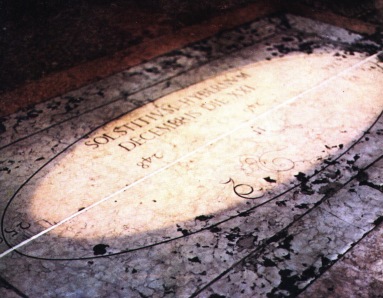 The
accuracy of the construction of the meridian line allowed Cassini to achieve
other important results with it as well: a new determination of the obliquity
of the ecliptic, 23°29'15", just 22" higher than the actual one, and new
measurements of refraction (i.e. the deviation that the light of a star
undergoes when it crosses the atmosphere, making it appear higher above the
horizon), which were used for over a century.
The
accuracy of the construction of the meridian line allowed Cassini to achieve
other important results with it as well: a new determination of the obliquity
of the ecliptic, 23°29'15", just 22" higher than the actual one, and new
measurements of refraction (i.e. the deviation that the light of a star
undergoes when it crosses the atmosphere, making it appear higher above the
horizon), which were used for over a century.
In his 1736 work De Gnomone Meridiano Bononiensi, Eustachio Manfredi
analysed eighty years of observations conducted using the meridian line,
demonstrating that the obliquity of the ecliptic – the circle apparently
described by the Sun in the heavens over the course of one year and actually
corresponding to the plane of the Earth’s orbit around the Sun – decreased by
less than one second a year.
This decrease of obliquity reflects the straightening of the Earth’s rotational
axis with respect to the plane on which the Earth orbits the Sun, the prime
cause of seasonal variations. As J.L. Heilbron pointed out, the astronomers
who made these observations using the great meridian line at San Petronio had
the honour of being the first to discover and measure a process that, if it
remained unchanged, would do away with the seasons in less than 2000 centuries!
But, in the second half of XVIIIth century, after Leonhard Euler attributed
the shift of planetary rotation axes to mutual gravitational interactions,
Pierre Simon marquis de Lapalce demonstrated that the decrease of ecliptic
obliquity, by first revealed and measured by astronomers who observed with
the big meridian line in San Petronio, actually was a periodic shift: our
season are safe and sound!
Fabrizio Bònoli
|
|
|